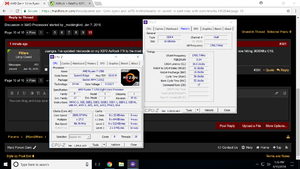Last edited:
Navigation
Install the app
How to install the app on iOS
Follow along with the video below to see how to install our site as a web app on your home screen.
Note: This feature may not be available in some browsers.
More options
You are using an out of date browser. It may not display this or other websites correctly.
You should upgrade or use an alternative browser.
You should upgrade or use an alternative browser.
AMD launches Zen+ 12nm Ryzen and X470 motherboards
- Thread starter _mockingbird
- Start date
OrangeKhrush
[H]ard|Gawd
- Joined
- Dec 15, 2016
- Messages
- 1,673
The AGESA fix was more of a system stability and unlocking potential for higher clocks mostly on memory, running more aggressive profiles than prior AGESA BIOS settings. Very few boards could do 3200mhz pre update, after the update we got a board to exceed 3600mhz
funkydmunky
2[H]4U
- Joined
- Aug 28, 2008
- Messages
- 3,870
TrueFree coolers are great for some. Not for the [H]ard, though.
But first gen Ryzen hit a wall @4 GHz, and throwing $$ on a cooler was often a waste. Here's for hoping different though!
Xuper
n00b
- Joined
- Apr 7, 2018
- Messages
- 23
Once again, the answer to your question is in #342. Read it carefully, because they explain why CL16 --> CL12 RAM improves performance, but AGESA 1.0.0.2 --> 1.0.0.4 does not.
Read my link :
I exactly wrote what quote said.if they say :
then How come they get zero performance but "The Stilt" did test on hitman and got 16% more fps? OC3D only tested AIDA.either AMD used an algorithms to show fake numbers or Bench is wrong.Who knows.
Edit : I found one :
https://thetechaltar.com/amd-ryzen-agesa-1-0-0-4-testing/
Xuper
n00b
- Joined
- Apr 7, 2018
- Messages
- 23
He doesn't want to talk about Latest AGESA pinnaclePI (1.0.0.2a according to elmor) , only version 1.0.0.2 to 1.0.0.4Juangra. I've updated microcode on my X370 AsRock ITX to the most recent. Before updating I could only hit 2800Mhz, after updating I am now hitting 3600Mhz C16. Hell, this speed isn't even on my motherboards supported list. Edit: Was able to reclock to 3.8Ghz and it is indeed all stable.
View attachment 65784
Last edited:
The AGESA fix was more of a system stability and unlocking potential for higher clocks mostly on memory, running more aggressive profiles than prior AGESA BIOS settings. Very few boards could do 3200mhz pre update, after the update we got a board to exceed 3600mhz
I don't consider my AsRock X370 ITX to be a very highend board. It had NO problem hitting 3600Mhz after the AGESA update though. I use the G.Skill Cas16 3600Mhz B-Side kit.
Juangra. I've updated microcode on my X370 AsRock ITX to the most recent. Before updating I could only hit 2800Mhz, after updating I am now hitting 3600Mhz C16. Hell, this speed isn't even on my motherboards supported list. Edit: Was able to reclock to 3.8Ghz and it is indeed all stable.
View attachment 65784
Someone else used a similar argument and I replied him.
Read my link :
I did, and the reply to your questions continues being in the post that I mention you again and again.
He doesn't want to talk about Latest AGESA pinnaclePI (1.0.0.2a according to elmor) , only version 1.0.0.2 to 1.0.0.4
We can discuss anything, but not mix things or move the goalpost.
Xuper
n00b
- Joined
- Apr 7, 2018
- Messages
- 23
I did, and the reply to your questions continues being in the post that I mention you again and again.
One reviewer Claimed AMD confirmed it and said Zero performance.One Benched and said average 2.45% more performance in games at least according to Link , Who is right? You still repeat it and I still don't accept.You don't need to reply.
One reviewer Claimed AMD confirmed it and said Zero performance.One Benched and said average 2.45% more performance in games at least according to Link , Who is right? You still repeat it and I still don't accept.You don't need to reply.
2.45% is within the error margin.
Someone else used a similar argument and I replied him.
I did, and the reply to your questions continues being in the post that I mention you again and again.
We can discuss anything, but not mix things or move the goalpost.
Not an arguement. You just seem to try and bash AMD on anything possible. You are diminutive to the company. I own an 8700K PC and an R7 1700, I enjoy them both for their strengths and weaknesses alike. I've got better things to do than to bash a company on every social media platform possible however.
Xuper
n00b
- Joined
- Apr 7, 2018
- Messages
- 23
2.45% is within the error margin.
Yes , 4.33% and 6.07% is within the error margin !
One reviewer Claimed AMD confirmed it and said Zero performance.One Benched and said average 2.45% more performance in games at least according to Link , Who is right?
Both can be right.
Two changes accompany these BIOS, the first concerns the DRAM Gear Down mode. When active, timed at 2666, some memory timings are released, including commands that switch to 2T instead of 1T. The second is called BankGroupSwap, and beyond the name we have no specific explanation of its role to give you for now.
From what we could see, the BIOS 5704 with which we had our tests Ryzen 7 already had the DRAM Gear Down Mode disabled, explaining the lack of gain. This was not the case for other public BIOS distributed by the motherboard manufacturers, we will come back to it.
So, guys with a defective original BIOS/AGESA saw the massive 2.45% gain that you quote, when updating to the new version, whereas rest of people didn't see any gain.
Not an arguement. You just seem to try and bash AMD on anything possible. You are diminutive to the company. I own an 8700K PC and an R7 1700, I enjoy them both for their strengths and weaknesses alike. I've got better things to do than to bash a company on every social media platform possible however.
Your first post used an argument had been debunked earlier. In your second post you already turn to ad hominem. It is really very interesting how giving accurate information (even AMD agrees with it) is "bashing AMD" according to some of you. The only way to not get such personal attacks is to post fantasies and false info, right?
sirmonkey1985
[H]ard|DCer of the Month - July 2010
- Joined
- Sep 13, 2008
- Messages
- 22,414
My first post was just a statement, be excited for AMD to support 3600Mhz+! When AMD wins, we all win.
i'll just be happy if i can get 3200mhz on my ripjaw V(hynix).. but not the end of the world if they can't fix it.
Last edited:
SighTurtle
[H]ard|Gawd
- Joined
- Jul 29, 2016
- Messages
- 1,410
GamersNexus got CPUs through a side-channel, while somewhat I guess respecting the embargo, they published a video and article talking about their experiences in testing these chips and how Ryzen+ launch is coming along plus some memory scaling testing.
Notably, they discuss XFR2 and their decision on whether to include it in results or not, and talk a bit about how memory can possibly hugely affect game performance.
I'm liking the sound of this launch vs Ryzen last year, GN is stating that platform stability and maturity is greatly improved, and with the new motherboards AMD has tightened specifications. I was a little on the fence during Ryzen due to poor memory support but this improvement is welcome and should relieve concerns from last year.
Edit: Anandtech says all CPUs get a stock cooler, vs last year where certain models did not. Nice to see AMD finally not being cheap with these coolers, which are much better vs Intel's stock garbage.
Notably, they discuss XFR2 and their decision on whether to include it in results or not, and talk a bit about how memory can possibly hugely affect game performance.
I'm liking the sound of this launch vs Ryzen last year, GN is stating that platform stability and maturity is greatly improved, and with the new motherboards AMD has tightened specifications. I was a little on the fence during Ryzen due to poor memory support but this improvement is welcome and should relieve concerns from last year.
Edit: Anandtech says all CPUs get a stock cooler, vs last year where certain models did not. Nice to see AMD finally not being cheap with these coolers, which are much better vs Intel's stock garbage.
Last edited:
RanceJustice
Supreme [H]ardness
- Joined
- Jun 9, 2003
- Messages
- 6,629
I'll probably pick up one of these given that I need to rebuild my Core 2 Quad era server box! Is the 2700X supposed to be the top of the line this time, or will there be a 2800X? I figure that the 2700X is probably easily worth a few extra bucks over the baseline 2700, given the speed increase alone; iI wonder if it is also binned for better overclocking. I can only hope these Zen+ chips can OC to 4.5ghz at least, on all cores! I'm also curious about the "Wraith Prism" cooler - I am guessing by the name it is the RGB lit variety and probably the highest performance, improved variant for Zen+? I wonder how it compares to high quality after-market air coolers from Scythe, Noctua, and others. Sure, it may not be the absolute winner, but if it is at parity with the top tier air coolers and enables a solid OC as I described above (or at very least 4.3ghz all cores) it may be an even better deal, as those who were not going to liquid may nor need to buy an additional cooler.
I'm looking at picking it up from Amazon and/or Microcenter - don't they both usually have some sort of deal with lower prices especially if you buy a motherboard? Speaking of that, its nice you can pre-order the CPU, but about the motherboards? I assume that X470 will be the new top of the line and if I recall there was some buzz about significant improvements. It looks like Asus has a ROG posting announcement, but it isn't actually visible yet. Hopefully the Crosshair will again be "the" motherboard to pick up especially for OCing and other great features. With luck the higher end motherboards will be available at launch from a the usual high-tier manufacturers.
I'm looking at picking it up from Amazon and/or Microcenter - don't they both usually have some sort of deal with lower prices especially if you buy a motherboard? Speaking of that, its nice you can pre-order the CPU, but about the motherboards? I assume that X470 will be the new top of the line and if I recall there was some buzz about significant improvements. It looks like Asus has a ROG posting announcement, but it isn't actually visible yet. Hopefully the Crosshair will again be "the" motherboard to pick up especially for OCing and other great features. With luck the higher end motherboards will be available at launch from a the usual high-tier manufacturers.
Last edited:
_mockingbird
Gawd
- Joined
- Feb 20, 2017
- Messages
- 992
I'll probably pick up one of these given that I need to rebuild my Core 2 Quad era server box! Is the 2700X supposed to be the top of the line this time, or will there be a 2800X? I figure that the 2700X is probably easily worth a few extra bucks over the baseline 2700, given the speed increase alone; iI wonder if it is also binned for better overclocking. I can only hope these Zen+ chips can OC to 4.5ghz at least, on all cores! I'm also curious about the "Wraith Prism" cooler - I am guessing by the name it is the RGB lit variety and probably the highest performance, improved variant for Zen+? I wonder how it compares to high quality after-market air coolers from Scythe, Noctua, and others. Sure, it may not be the absolute winner, but if it is at parity with the top tier air coolers and enables a solid OC as I described above (or at very least 4.3ghz all cores) it may be an even better deal, as those who were not going to liquid may nor need to buy an additional cooler.
I'm looking at picking it up from Amazon and/or Microcenter - don't they both usually have some sort of deal with lower prices especially if you buy a motherboard? Speaking of that, its nice you can pre-order the CPU, but about the motherboards? I assume that X470 will be the new top of the line and if I recall there was some buzz about significant improvements. It looks like Asus has a ROG posting announcement, but it isn't actually visible yet. Hopefully the Crosshair will again be "the" motherboard to pick up especially for OCing and other great features.
Ryzen 7 2700X is the top of the line.
4.3 GHz is a realistic overclock. 4.5 GHz requires really high (and probably unsafe) voltage
Wraith Prism is about on par with the Cooler Master Hyper 212 EVO
RanceJustice
Supreme [H]ardness
- Joined
- Jun 9, 2003
- Messages
- 6,629
Anyone know why 2700X is top of the line this time? Think its going to "stay" as the top chip for Zen+ AM4? I don't know how likely it is for AMD to do so, but I don't want them to launch with the 2700X now and then a few months down the road they push out a 2800X or other chip? Are they getting rid of "Black Edition" branding by the way? Perhaps X takes the place of that.
I'm glad the 4.3 is realistic this go round, but you think 4.5 is going to be that difficult? I know Ryzen doesn't have much OC room, hopefully Zen+ is a bit better, but there's something a tad disheartening about not being able to overclock and get all-core turbo any higher than the default single core turbo value. Granted it won't be a total travesty especially as this will be a secondary/server machine for me, but it would be nice to be able to make a little higher on good air / AIO water, or especially custom-grade water.
Ah, so its on par with Hyper 212 EVO? That's pretty good then, for air, if I recall. I wonder if replacing the fan could give it even better performance. Given the pre-order page, it seems that only the 2700X comes with the Wraith Prism, where the others use Spire+RGB, Spire, or Stealth. Is the Prism a new design for Zen+ (or perhaps a revamped version at least) or is it the same as the original Ryzen coolers? Think it will handle that 4.3/4.4 ghz OC suitably at least? Kind of too bad they don't offer an OEM version for a little cheaper without the cooler.
I'm glad the 4.3 is realistic this go round, but you think 4.5 is going to be that difficult? I know Ryzen doesn't have much OC room, hopefully Zen+ is a bit better, but there's something a tad disheartening about not being able to overclock and get all-core turbo any higher than the default single core turbo value. Granted it won't be a total travesty especially as this will be a secondary/server machine for me, but it would be nice to be able to make a little higher on good air / AIO water, or especially custom-grade water.
Ah, so its on par with Hyper 212 EVO? That's pretty good then, for air, if I recall. I wonder if replacing the fan could give it even better performance. Given the pre-order page, it seems that only the 2700X comes with the Wraith Prism, where the others use Spire+RGB, Spire, or Stealth. Is the Prism a new design for Zen+ (or perhaps a revamped version at least) or is it the same as the original Ryzen coolers? Think it will handle that 4.3/4.4 ghz OC suitably at least? Kind of too bad they don't offer an OEM version for a little cheaper without the cooler.
_mockingbird
Gawd
- Joined
- Feb 20, 2017
- Messages
- 992
Anyone know why 2700X is top of the line this time? Think its going to "stay" as the top chip for Zen+ AM4? I don't know how likely it is for AMD to do so, but I don't want them to launch with the 2700X now and then a few months down the road they push out a 2800X or other chip? Are they getting rid of "Black Edition" branding by the way? Perhaps X takes the place of that.
Last time around, the Core i7-6900K was selling for ~$1049, so AMD was free to launch so many 8-cores processors.
This time, the Core i7-7820X is selling for ~$469 (initially launched $599), so AMD don't have room to launch so many 8-cores processors.
I'm glad the 4.3 is realistic this go round, but you think 4.5 is going to be that difficult? I know Ryzen doesn't have much OC room, hopefully Zen+ is a bit better, but there's something a tad disheartening about not being able to overclock and get all-core turbo any higher than the default single core turbo value. Granted it won't be a total travesty especially as this will be a secondary/server machine for me, but it would be nice to be able to make a little higher on good air / AIO water, or especially custom-grade water.
4.5 GHz is achievable, but not with any reasonable voltage
Ah, so its on par with Hyper 212 EVO? That's pretty good then, for air, if I recall. I wonder if replacing the fan could give it even better performance. Given the pre-order page, it seems that only the 2700X comes with the Wraith Prism, where the others use Spire+RGB, Spire, or Stealth. Is the Prism a new design for Zen+ (or perhaps a revamped version at least) or is it the same as the original Ryzen coolers? Think it will handle that 4.3/4.4 ghz OC suitably at least? Kind of too bad they don't offer an OEM version for a little cheaper without the cooler.
The Wraith Prism is on-par with the Cooler Master Hyper 212 EVO.
It probably has something to do with Cooler Mastering being the one that made the Wraith Prism.
I went ahead and pre-ordered the 2700x, should give a nice boost from my 1700. I'm hoping the XFR2 and precision boost curves can be modified ala p-state overclocking, would be cool if we could just ramp everything up 200mhz with added cooling instead of just going all core and gaining nothing in lower threaded apps.
_mockingbird
Gawd
- Joined
- Feb 20, 2017
- Messages
- 992
I went ahead and pre-ordered the 2700x, should give a nice boost from my 1700. I'm hoping the XFR2 and precision boost curves can be modified ala p-state overclocking, would be cool if we could just ramp everything up 200mhz with added cooling instead of just going all core and gaining nothing in lower threaded apps.
ASUS already went ahead of you and added that to the ROG Crosshair VI Hero
_mockingbird
Gawd
- Joined
- Feb 20, 2017
- Messages
- 992
Review: AMD Ryzen 7 2700X (X470)
BY IVÁN MARTÍNEZ
04/13/2018
CPUS & APUS
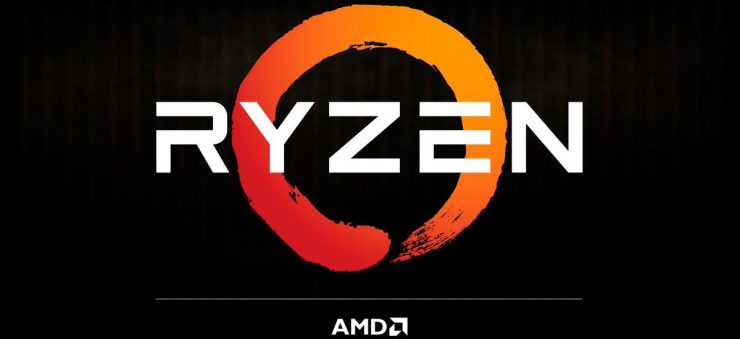
After analyzing just a week ago the new AMD Ryzen 7 2700X on an X370 platform , today we have the possibility to test it on a high-end X470 motherboard , although we can not reveal which one. Therefore, we have done the performance tests again and added the tests on games, solving in a stroke the problem that we found in our previous review.
Let's see first its complete technical specifications :
AMD Ryzen 7 2700X
Socket AM4
Fabrication process 12 nm
Cores / Threads 8 cores / 16 threads
Base Frequency 3.70 GHz
Turbo Frequency 4.35 GHz
Cache L3 2 × 8 MB
Compatible Memory DDR4-2933 Dual-Channel
PCIe lines 16 lines
TDP
Before starting the review, we want to thank AMD for not sending us their products and therefore not forcing us to sign their NDA , so we can offer you before anyone, for the second time, this review.
Index of contents [Ocultar]
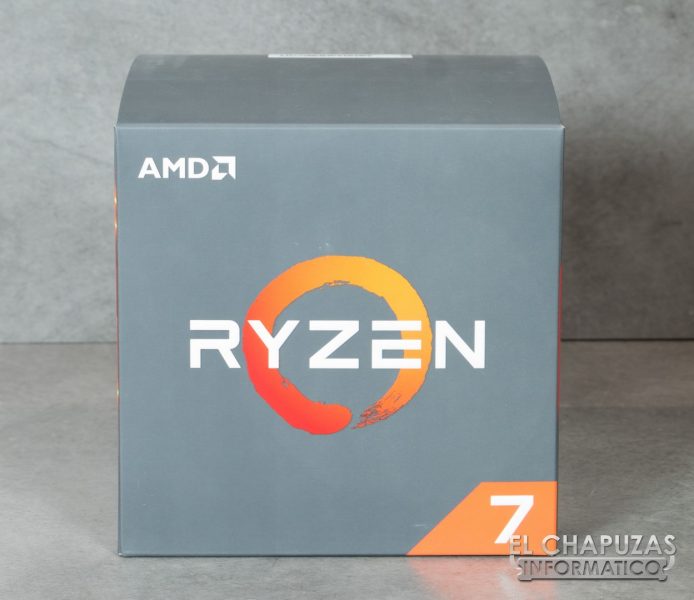
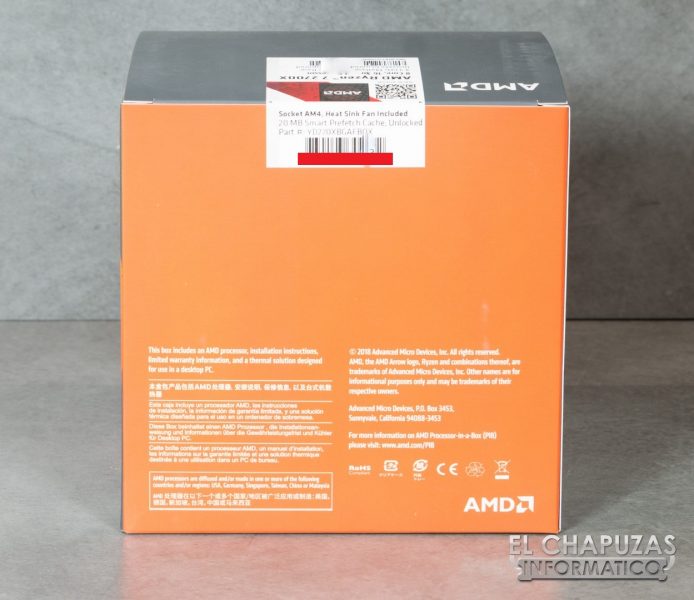
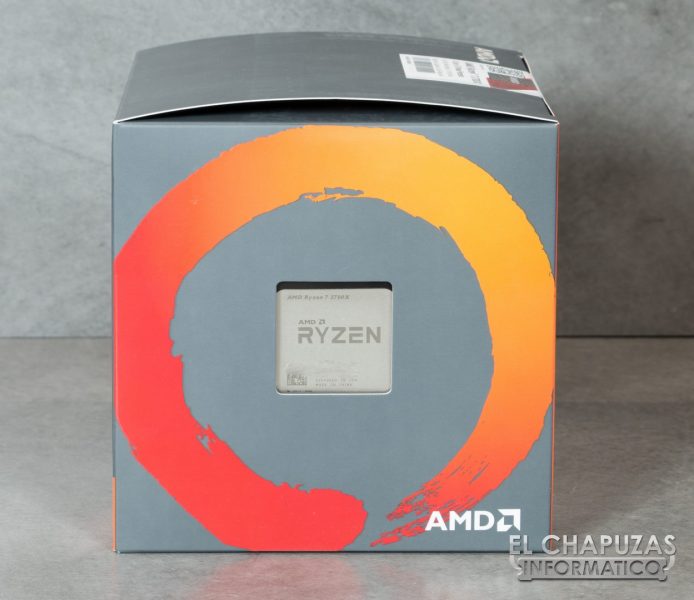

The AMD Ryzen 7 2700X comes in a box similar to the previous generation design, showing the processor from the side and protecting it perfectly inside, as well as the heatsink.
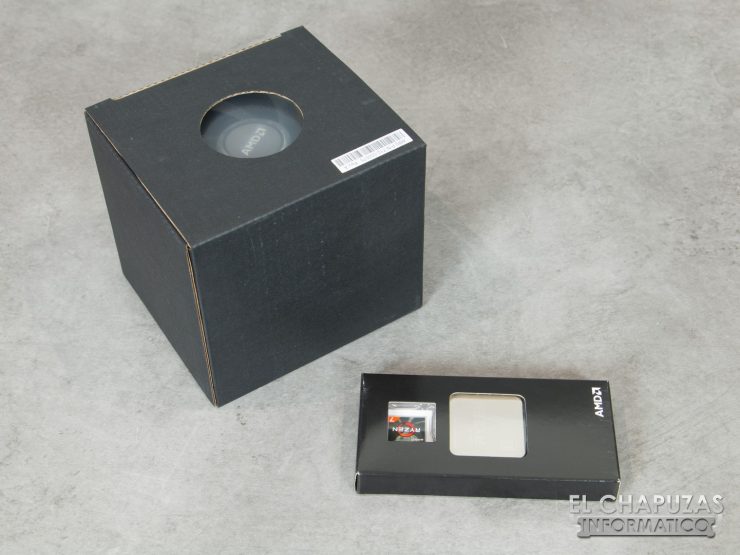
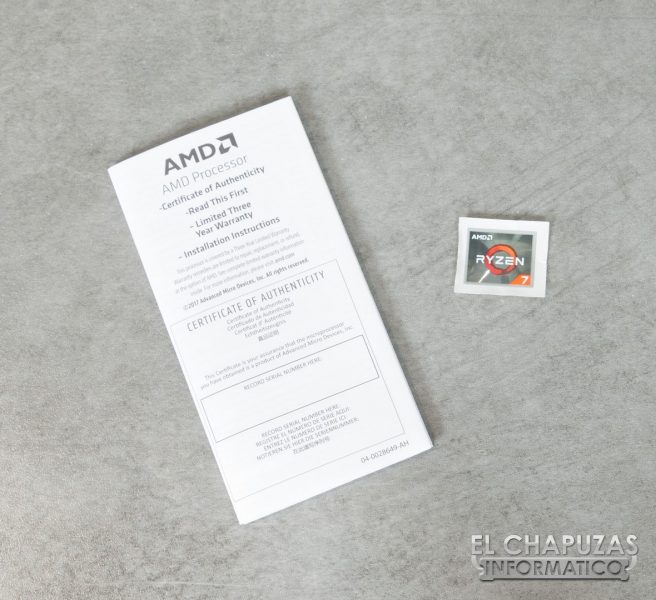
In addition to the warranty card and a sticker of Ryzen 7, this model comes with the AMD Wraith Prism , a model that acquires RGB LED lighting configurable from a USB header or from plates compatible with RGB strips , so we can customize your lighting to taste.


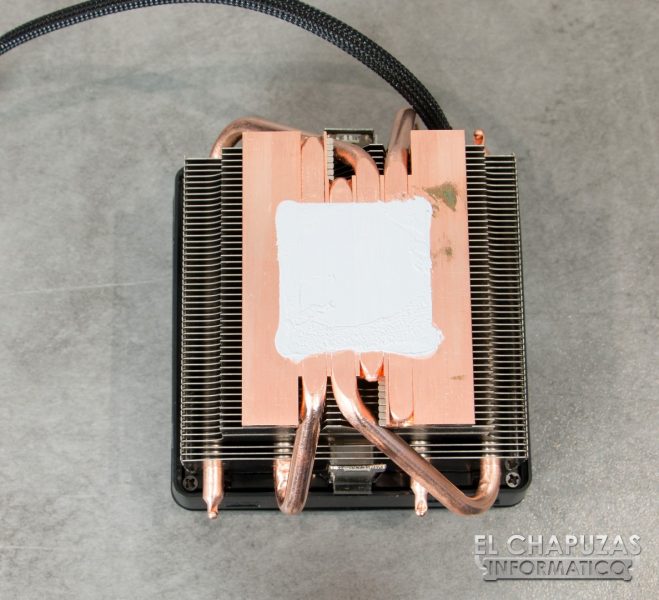
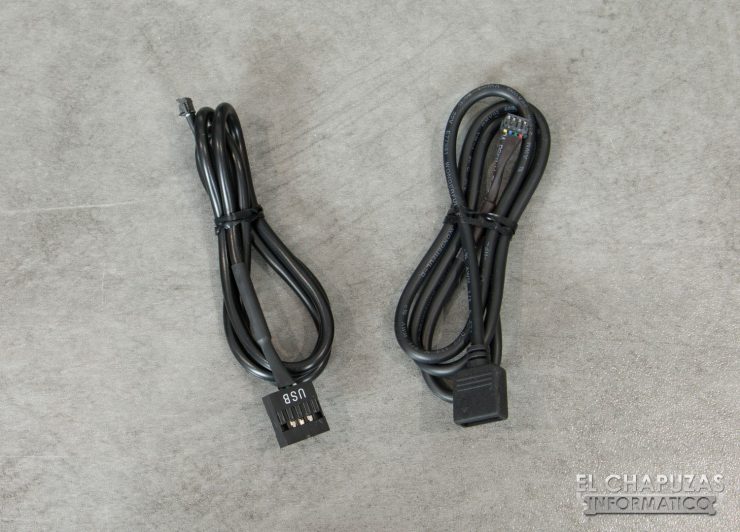
AMD Ryzen 7 2700X
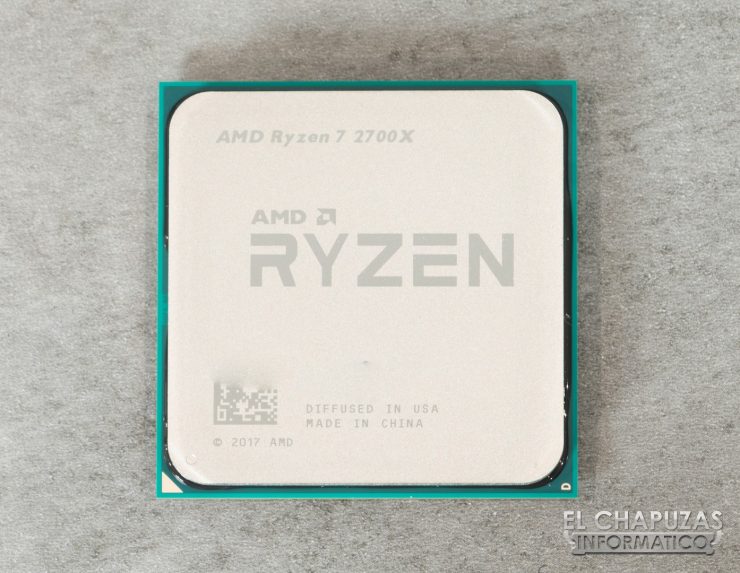
As we anticipated, the AMD Ryzen 7 2700X offers 8 cores , which in turn offer 16 threads that start from a base frequency of 3.7 GHz to reach 4.35 GHz in Turbo mode thanks to the XFR 2 automatic overclocking technologies and Precision Boost Overdrive . It offers a total of 2 × 8 MB of L3 cache , as well as 8 x 512 KB of L2 cache and 8 x 32 KB + 8 x 64 KB of L1 cache, so it offers a cache distribution identical to that of the Ryzen 7 1700X .
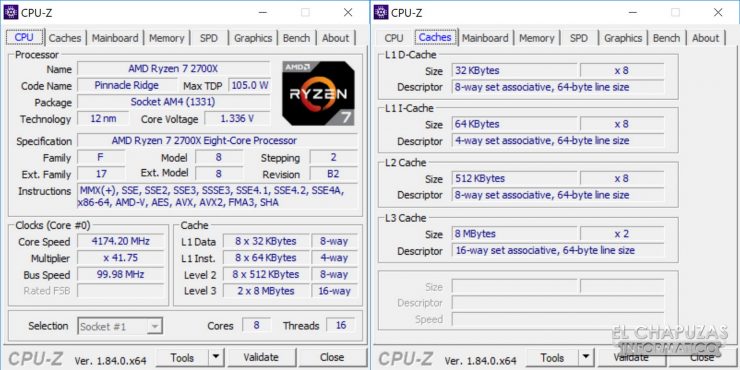
As we can see in CPU-Z , the set of instructions supported has MMX (+), SSE, SSE2, SSE3, SSSE3, SSE4.1, SSE4.2, SSE4A, x86-64, AMD-V, AES, AVX, AVX2, FMA3 and SHA, also the same as in the first generation of Ryzen .
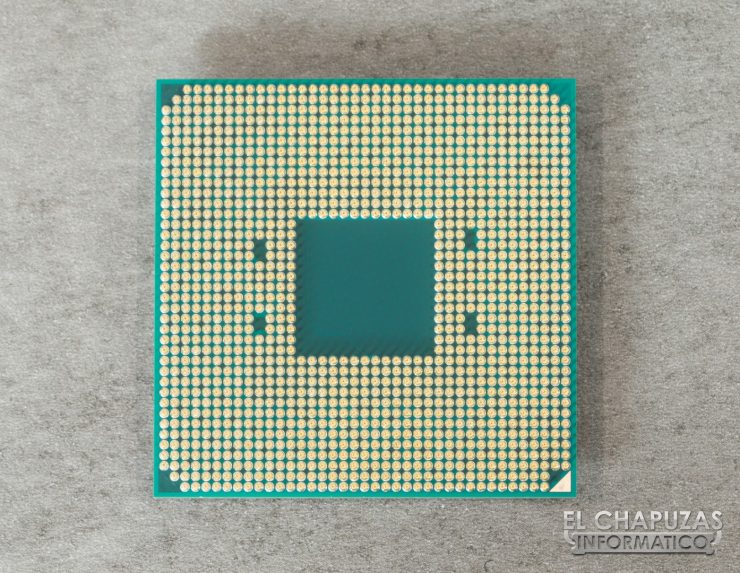
Obviously it is a processor for the AM4 socket and therefore makes use of the " Pin Grip Array " connection system, where the pins are in the processor and not in the motherboard, highlighting the use of a total of 1,331 contacts.
BY IVÁN MARTÍNEZ
04/13/2018
CPUS & APUS

After analyzing just a week ago the new AMD Ryzen 7 2700X on an X370 platform , today we have the possibility to test it on a high-end X470 motherboard , although we can not reveal which one. Therefore, we have done the performance tests again and added the tests on games, solving in a stroke the problem that we found in our previous review.
Let's see first its complete technical specifications :
AMD Ryzen 7 2700X
Socket AM4
Fabrication process 12 nm
Cores / Threads 8 cores / 16 threads
Base Frequency 3.70 GHz
Turbo Frequency 4.35 GHz
Cache L3 2 × 8 MB
Compatible Memory DDR4-2933 Dual-Channel
PCIe lines 16 lines
TDP
Before starting the review, we want to thank AMD for not sending us their products and therefore not forcing us to sign their NDA , so we can offer you before anyone, for the second time, this review.
Index of contents [Ocultar]
- 1 Packaging and Accessories
- 2 AMD Ryzen 7 2700X
- 3 Testing Equipment
- 4 Synthetic Tests
- 5 Games
- 6 Temperature, Overclocking and Consumption
- 7 Conclusion




The AMD Ryzen 7 2700X comes in a box similar to the previous generation design, showing the processor from the side and protecting it perfectly inside, as well as the heatsink.


In addition to the warranty card and a sticker of Ryzen 7, this model comes with the AMD Wraith Prism , a model that acquires RGB LED lighting configurable from a USB header or from plates compatible with RGB strips , so we can customize your lighting to taste.




AMD Ryzen 7 2700X

As we anticipated, the AMD Ryzen 7 2700X offers 8 cores , which in turn offer 16 threads that start from a base frequency of 3.7 GHz to reach 4.35 GHz in Turbo mode thanks to the XFR 2 automatic overclocking technologies and Precision Boost Overdrive . It offers a total of 2 × 8 MB of L3 cache , as well as 8 x 512 KB of L2 cache and 8 x 32 KB + 8 x 64 KB of L1 cache, so it offers a cache distribution identical to that of the Ryzen 7 1700X .

As we can see in CPU-Z , the set of instructions supported has MMX (+), SSE, SSE2, SSE3, SSSE3, SSE4.1, SSE4.2, SSE4A, x86-64, AMD-V, AES, AVX, AVX2, FMA3 and SHA, also the same as in the first generation of Ryzen .

Obviously it is a processor for the AM4 socket and therefore makes use of the " Pin Grip Array " connection system, where the pins are in the processor and not in the motherboard, highlighting the use of a total of 1,331 contacts.
_mockingbird
Gawd
- Joined
- Feb 20, 2017
- Messages
- 992
Test Equipment
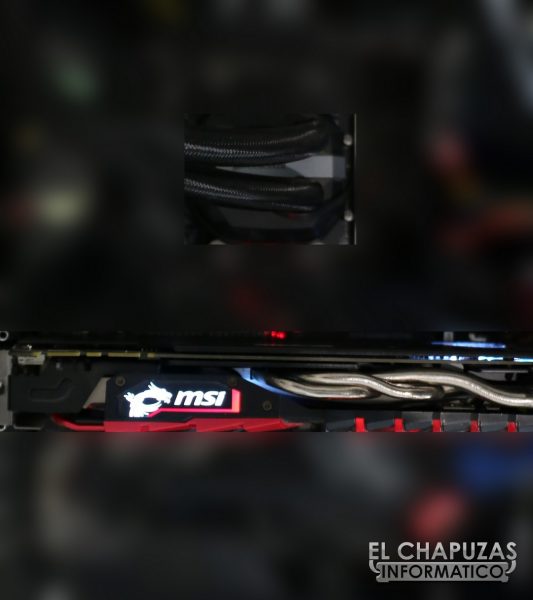
To analyze the performance of the AMD Ryzen 7 2700X processor we have assembled the following test equipment:
Synthetic Tests
Next, we show you the results of the performance tests performed on this and other processors in calculation benchmarks (wPrime), rendering (Cinebench), coding (x264), memories (Aida64) or focused on games (3D Mark).
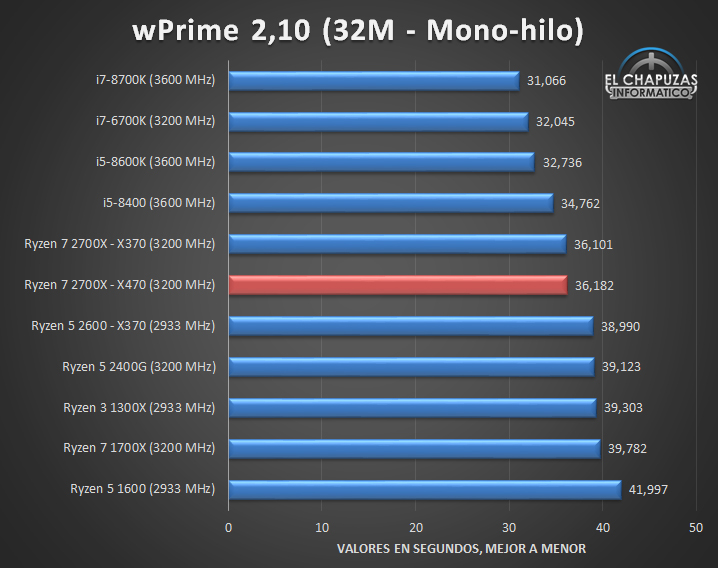
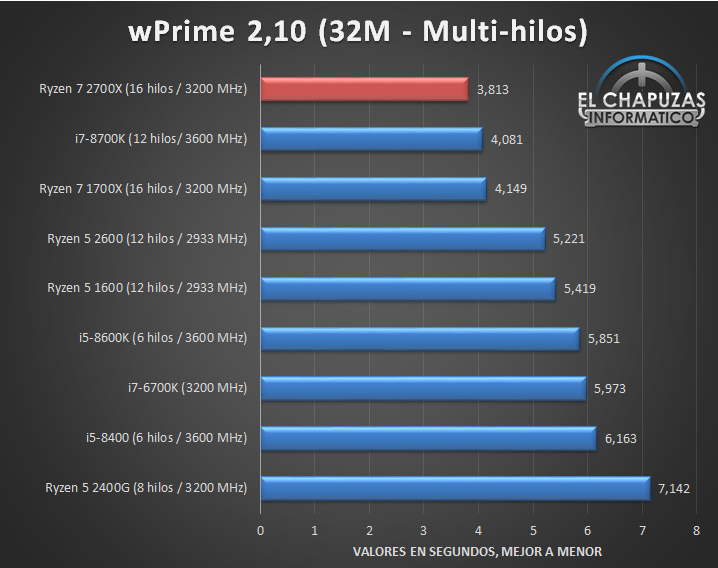
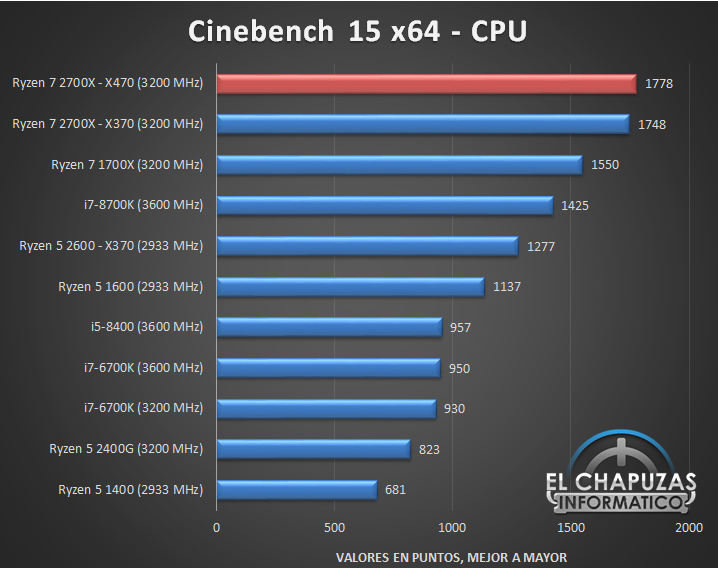

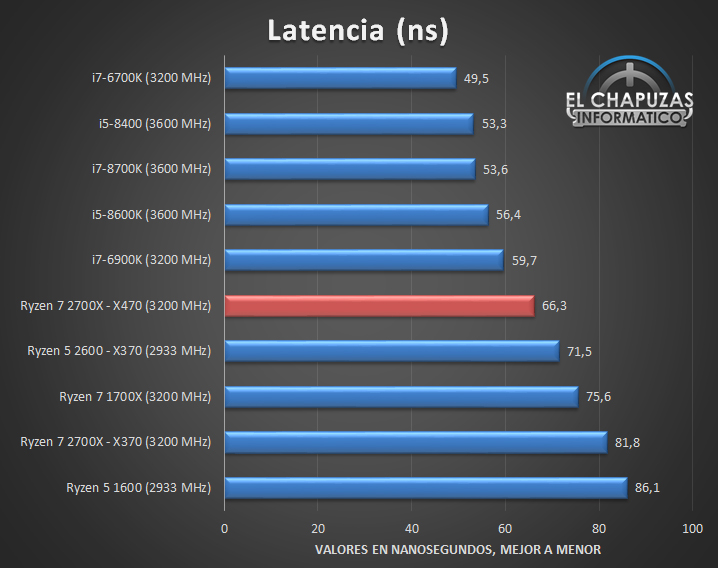
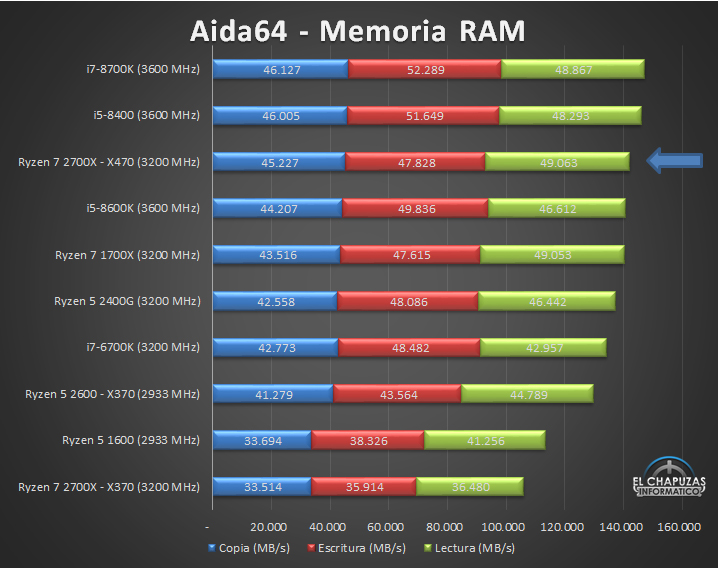
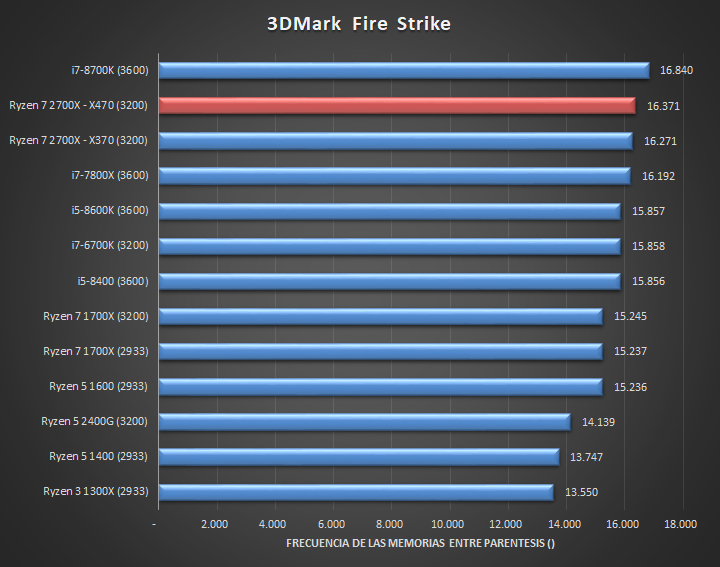

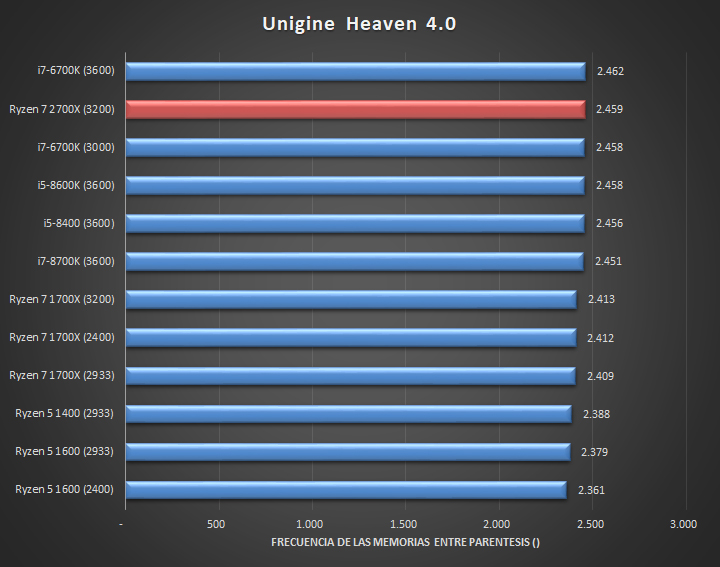
Games
Unlike the problems we had with the X370 platform, this time we were able to check the result in games without any type of contingency.

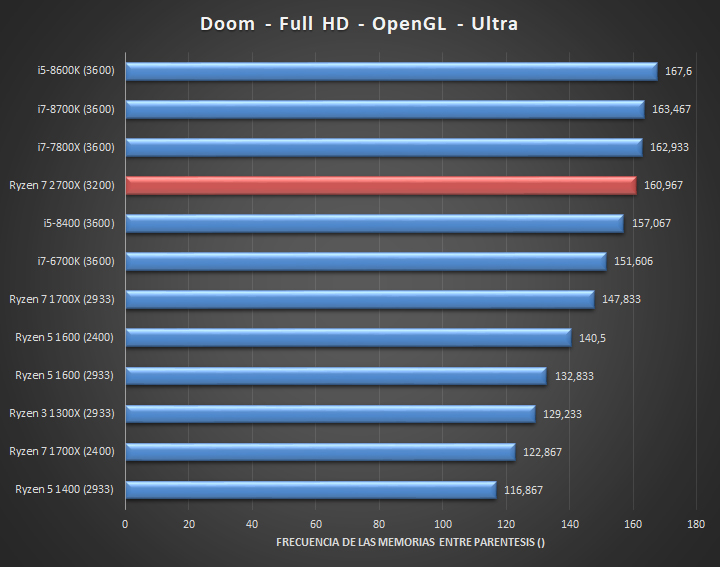

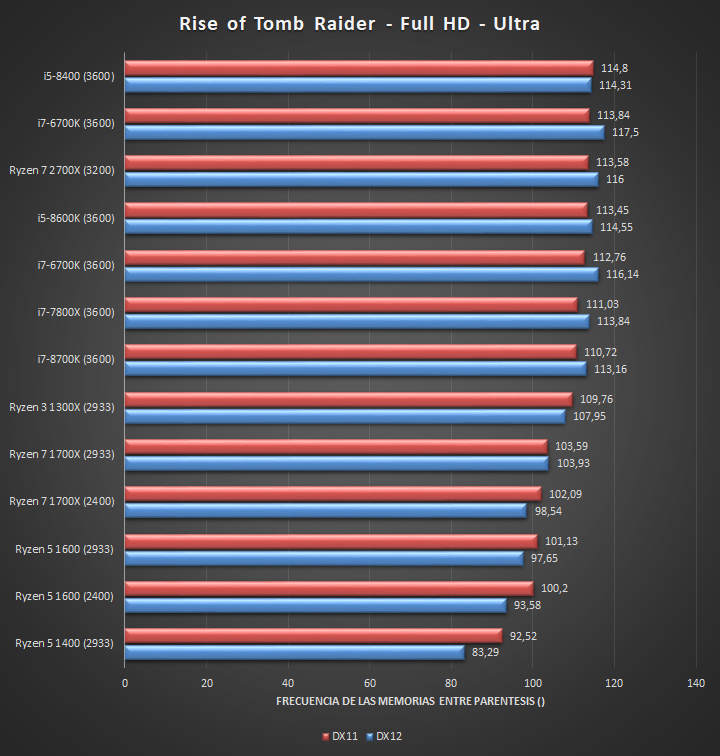
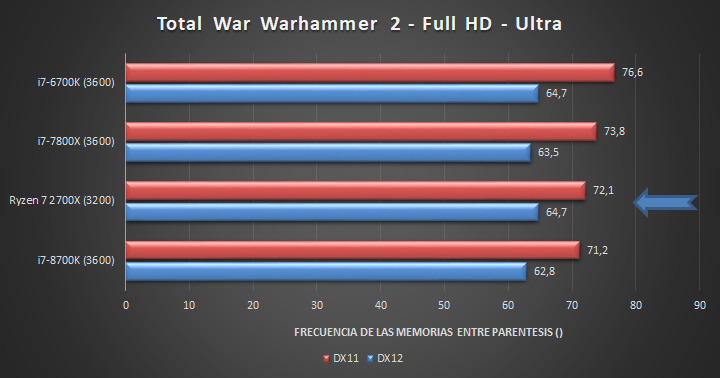
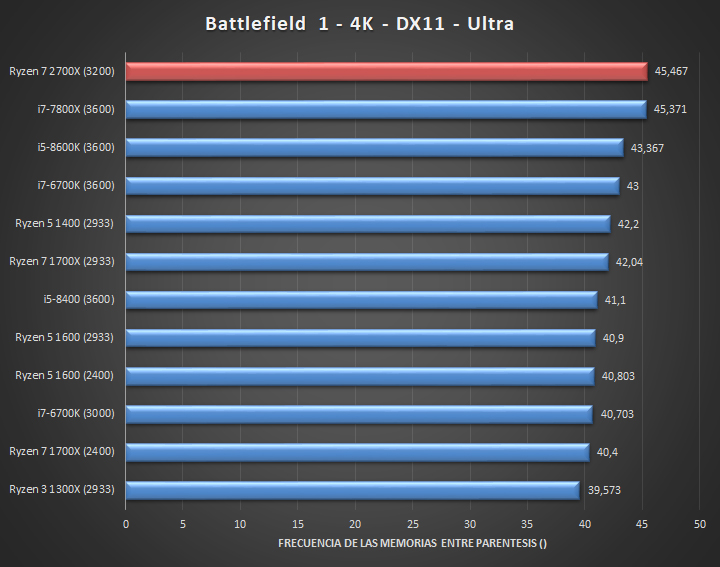
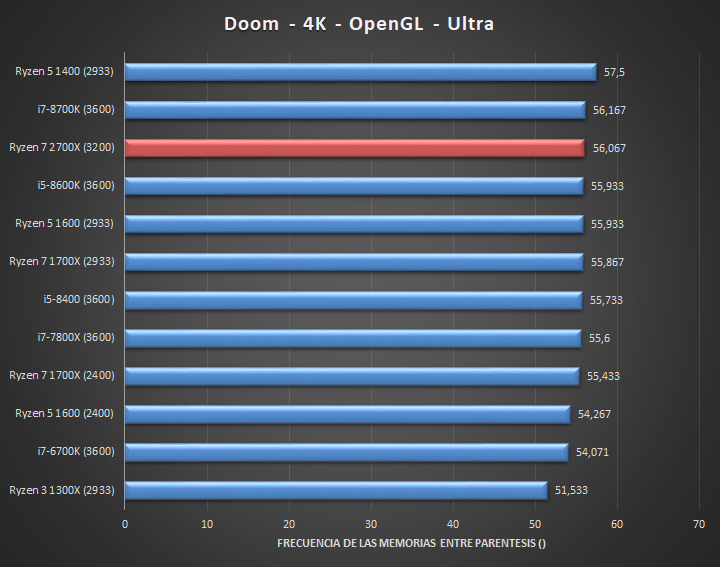

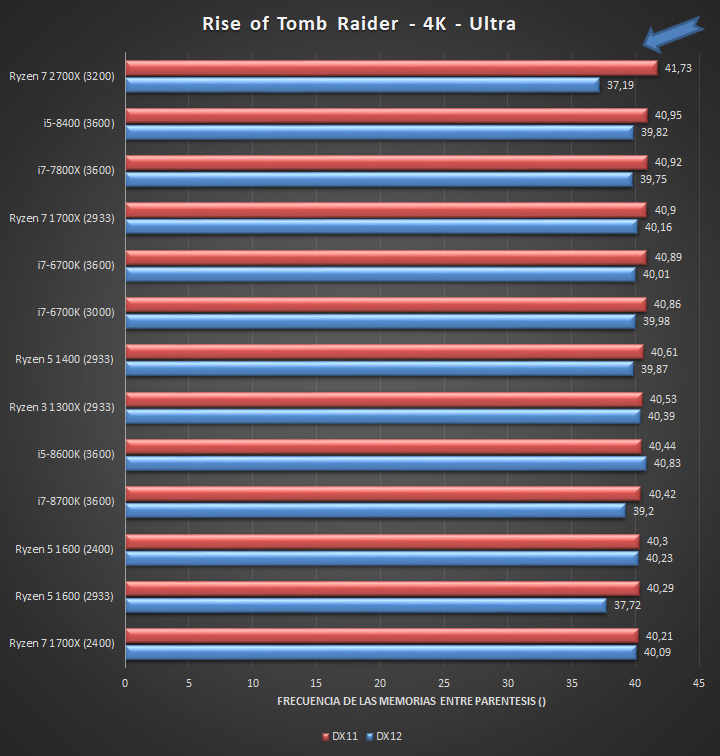
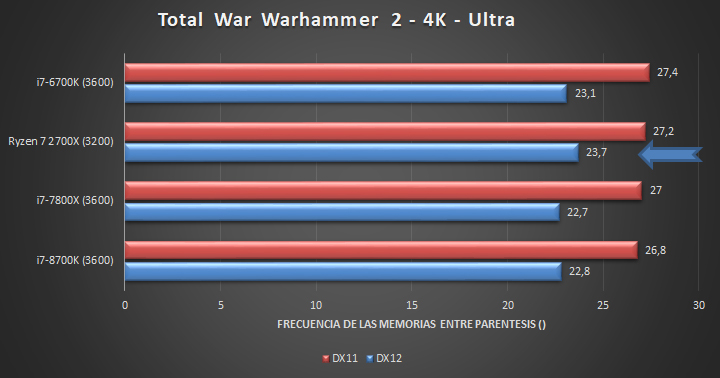
Temperature, Overclocking and Consumption
Under an ambient temperature of 20ºC, the AMD Ryzen 7 2700X offers temperatures of around 40ºC at rest and 65ºC in its stress test, a high value compared to the best results obtained with the reference heatsink under the X370 platform, so that we will have to wait to have Ryzen Master software to check it again, because it is not logical that they have increased with a liquid cooling.
On the consumption , to say that it has improved notably being around 210W for the complete equipment in the stress test of Aida64 (without discs or GPU). It is similar to that offered by the Intel i7 processors, improving the Ryzen 7 1700X by 40W .
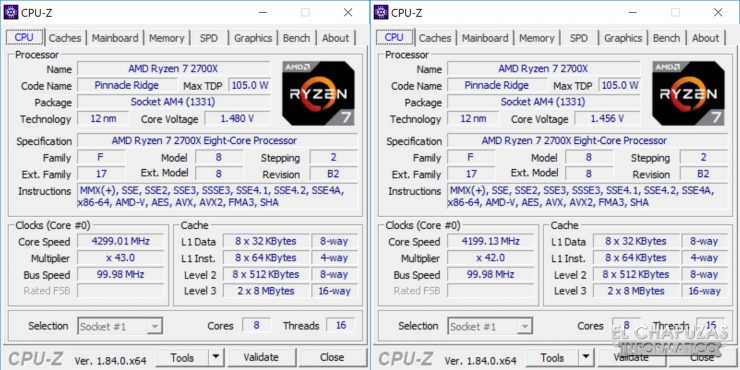
As we see in the previous captures, we have managed to reach 4.29 GHz , although they are not stable and we will have to "settle" with 4.19 GHz , which is not bad for all the cores, although using a voltage of 1.456v .
With this, we have managed to go from 1,778 points in Cinebench 15 to 1,893 points , an improvement of 6.5% , and from 16,371 to 16,478 in 3DMark Fire Strike , an improvement of 0.6% .
conclusion

As we already anticipated in the review of the X370 platform, the AMD Ryzen 7 2700X is a good review of the Ryzen 7 1700X with which AMD surprised us last year, improving it in all aspects.
On the one hand, we have higher frequencies , which even increase significantly with the new XFR 2 mode. This supposes an improvement around 10% in the different benchmarks that we have passed in front of its predecessor, something similar to what Intel offers in each new generation (up to the 8th). But it is that according to the results of the tests of OC, this technology exprime practically to the maximum the nuclei , taking them to frequencies very similar to their maxims, everything of transparent and automatic form .
But the big difference with the results obtained on the previous generation is found in games, where the performance offered by this AMD Ryzen 7 2700X is very similar to the alternatives Intel i7 8-wire , but the 12-wire and the future 16 threads surely surpass it.
From today, we can pre-buy the new generation of AMD Ryzen processors in the main stores of the sector, being able to acquire this AMD Ryzen 7 2700X for 325 euros in stores such as PcComponentes or Amazon . Taking into account that we can buy the Intel Core i7-8700K for 315 euros , it is not an easy choice between both, and more if we only give preference to games.
Main advantages
+ Good performance / price ratio for professional environments
+ Excellent multi-core performance (8 cores / 16 threads)
+ Notable performance improvement in games compared to the previous generation
+ Lower consumption than the 1700X with higher frequencies
+ Compatible with previous generation base plates
Negative aspects
- Price somewhat high, difficult choice versus the Intel i7
- Low overclocking capacity, the processor is squeezed a lot
Other Aspects
* Compatible with previous generation base plates, although somewhat green when launched
Therefore, from El Chapuzas Informático we awarded the Gold Award to this processor for its good improvement over the previous generation, although it still has much to prove, especially in games.

Read more: https://elchapuzasinformatico.com/2018/04/review-amd-ryzen-7-2700x-x470/

To analyze the performance of the AMD Ryzen 7 2700X processor we have assembled the following test equipment:
- ECI X470 motherboard with RGB's
- Memories G.Skill FlareX DDR4 @ 3200 MHz
- MSI GeForce GTX 1070 Gaming Z
- Liquid cooling Corsair H80i GT
- Be Quiet Font! Dark Power Pro 11 1200W
- Adata SU900 256GB SSD
- SSD Corsair LX 512 GB
- Operating System Windows 10 64 bits
Synthetic Tests
Next, we show you the results of the performance tests performed on this and other processors in calculation benchmarks (wPrime), rendering (Cinebench), coding (x264), memories (Aida64) or focused on games (3D Mark).









Games
Unlike the problems we had with the X370 platform, this time we were able to check the result in games without any type of contingency.










Temperature, Overclocking and Consumption
Under an ambient temperature of 20ºC, the AMD Ryzen 7 2700X offers temperatures of around 40ºC at rest and 65ºC in its stress test, a high value compared to the best results obtained with the reference heatsink under the X370 platform, so that we will have to wait to have Ryzen Master software to check it again, because it is not logical that they have increased with a liquid cooling.
On the consumption , to say that it has improved notably being around 210W for the complete equipment in the stress test of Aida64 (without discs or GPU). It is similar to that offered by the Intel i7 processors, improving the Ryzen 7 1700X by 40W .

As we see in the previous captures, we have managed to reach 4.29 GHz , although they are not stable and we will have to "settle" with 4.19 GHz , which is not bad for all the cores, although using a voltage of 1.456v .
With this, we have managed to go from 1,778 points in Cinebench 15 to 1,893 points , an improvement of 6.5% , and from 16,371 to 16,478 in 3DMark Fire Strike , an improvement of 0.6% .
conclusion

As we already anticipated in the review of the X370 platform, the AMD Ryzen 7 2700X is a good review of the Ryzen 7 1700X with which AMD surprised us last year, improving it in all aspects.
On the one hand, we have higher frequencies , which even increase significantly with the new XFR 2 mode. This supposes an improvement around 10% in the different benchmarks that we have passed in front of its predecessor, something similar to what Intel offers in each new generation (up to the 8th). But it is that according to the results of the tests of OC, this technology exprime practically to the maximum the nuclei , taking them to frequencies very similar to their maxims, everything of transparent and automatic form .
But the big difference with the results obtained on the previous generation is found in games, where the performance offered by this AMD Ryzen 7 2700X is very similar to the alternatives Intel i7 8-wire , but the 12-wire and the future 16 threads surely surpass it.
From today, we can pre-buy the new generation of AMD Ryzen processors in the main stores of the sector, being able to acquire this AMD Ryzen 7 2700X for 325 euros in stores such as PcComponentes or Amazon . Taking into account that we can buy the Intel Core i7-8700K for 315 euros , it is not an easy choice between both, and more if we only give preference to games.
Main advantages
+ Good performance / price ratio for professional environments
+ Excellent multi-core performance (8 cores / 16 threads)
+ Notable performance improvement in games compared to the previous generation
+ Lower consumption than the 1700X with higher frequencies
+ Compatible with previous generation base plates
Negative aspects
- Price somewhat high, difficult choice versus the Intel i7
- Low overclocking capacity, the processor is squeezed a lot
Other Aspects
* Compatible with previous generation base plates, although somewhat green when launched
Therefore, from El Chapuzas Informático we awarded the Gold Award to this processor for its good improvement over the previous generation, although it still has much to prove, especially in games.

Read more: https://elchapuzasinformatico.com/2018/04/review-amd-ryzen-7-2700x-x470/
tom_ozahoski
Limp Gawd
- Joined
- Feb 24, 2014
- Messages
- 361
Digital Viper-X-
[H]F Junkie
- Joined
- Dec 9, 2000
- Messages
- 15,116
Looking good! IF I hadn't build an 8700k box recently, I'd be springing for this instead.
Xuper
n00b
- Joined
- Apr 7, 2018
- Messages
- 23
3200 vs 3600.Why do they do this? surprising this one :

2700X is slower than 1600 in DX12 bench.How come?

2700X is slower than 1600 in DX12 bench.How come?
tom_ozahoski
Limp Gawd
- Joined
- Feb 24, 2014
- Messages
- 361
3200 vs 3600.Why do they do this? surprising this one :
View attachment 66615
2700X is slower than 1600 in DX12 bench.How come?
The difference is extremely minor and in DX12 it's the fastest. It can be drivers or firmware, who knows its still early.
ASUS already went ahead of you and added that to the ROG Crosshair VI Hero
Oh shit. Awesome!
I am a bit confused. I thought it was the cpu that affected latency and not the mb. In any case, the lower latency really closes the gap at 1080p gaming.
The midrange battle between the r5/b350 and i5/b360 really doesn't leave Intel much except a few fps at 1080p gaming. Can't wait until April 19th!
The midrange battle between the r5/b350 and i5/b360 really doesn't leave Intel much except a few fps at 1080p gaming. Can't wait until April 19th!
jenosmaverick
Limp Gawd
- Joined
- May 24, 2017
- Messages
- 142
Woooow great improvements in games! Just imagine Zen 2 next year! I'm surely grabbing an AMD next year.
kirbyrj
Fully [H]
- Joined
- Feb 1, 2005
- Messages
- 30,693
Looking good! IF I hadn't build an 8700k box recently, I'd be springing for this instead.
Which is why Intel rushed it out the door with the rehashed Z370 chipset.
Ohh my. I had no idea the Ryzen 2 and new X470 motherboards were releasing this soon. I had to sell my Ryzen 7 1700 system back during the holidays, and I've been itching to buy a complete new system.
Looks like I'll be getting the 2700X & Asus X470 CH7. But what memory should I go with? I want an RGB kit with 16G.
Looks like I'll be getting the 2700X & Asus X470 CH7. But what memory should I go with? I want an RGB kit with 16G.
Gideon
2[H]4U
- Joined
- Apr 13, 2006
- Messages
- 3,557
So the difference between X470 and X370 is insignificant, just as CPCHardware and others said.
Actually we all figured that and said that, only you were inferring that the x470 was needed for full performance and features of the new Zen chips. What we said was using the A series chipset was stupid in that review.
Actually we all figured that and said that, only you were inferring that the x470 was needed for full performance and features of the new Zen chips. What we said was using the A series chipset was stupid in that review.
That is just the contrary of what happened!
This thread is full of people that said that reviews would use X470 mobos, because performance would be crippled otherwise. That same people said that new features as XFR2 and Precision boost 2 are only available on 400-series mobos, and performance would be very inferior on 300-series mobos. This same people said that A320 mobo would cripple performance still more.
You can find dozens of posts from mine explaining that XFR2 and Precision Boost 2 are available on 300-series mobos and that X470 mobo would change performance by only 1% or 2%. And posts from miner demonstrating performance gaps between X370 and A320 mobos is in the 0--1% range. Below is a collection of some of my posts in this thread
A320 supports XFR 2. This is in the slides that were leaked days ago.
Some sites as videocardz are having trouble with the math of percentages. 175% is only a 8% faster than 161%, not 14% faster. The graph is correct.
You cannot do 175% - 161%, you have to do 175/161
The new Precission boost overdrive requires 400 series mobos. But what have been I saying since past year? What full performance would be only possible on new 400-series mobos? Funny that some people tried to crush me for saying that!
In any case overclocking in france esitmates a X470 mobo would add only 1--2% performance to Canard review results.
Ce qui implique que les CPU en question avaient leur Precision Boost désactivé, cette technologie n’étant que sur les cartes série 400. Cela ne change pas beaucoup les performances, 1 à 2% grand maximum, et ne change pas le ratio perf/conso en demi-teinte.
CPC Hardware explained before publication why are using A320 instead X370/X470: To avoid the omnipresent cheats in the X370/X470's BIOS ("Pour éviter les cheats à la con omniprésents dans les BIOS des X370/X470").
The overclockingmadeinfrance magazine also mentions that using a 400-series mobo wouldn't really change the performance or efficiency results, performance would change only 1 or 2% top maximum ("Cela ne change pas beaucoup les performances, 1 à 2% grand maximum").
Overclocking is a non-issue because CPC hardware tested all chips on stock settings.
300-series motherboards support both XFR 2 and Precision Boost 2. The only feature wasn't activated during the review was the new overdrive/enhancement boost, because that requires a 400-series motherboard. But as mentioned before
"They claimed that X470 is practically identical to X370 except for a few cosmetic changes." There is a rumor that X470 is simply a rebranded X370 with an improved BIOS. I will ask about it
According to CPCHardware and Overclocking made in france, replacing the A320 mobo by X470 only brings 1% or 2% moar performance. That is no "crippling" by any bit of imagination.
So mentioning that AMD refutes what techradar says about XFR2, mentioning that CPC review agrees with internal tests made by AMD, and asking if the GB mobo is 4+3 is... "attempting to bring AMD down"?
And don't forget that all what I wrote to Linus was correct.
I don't think what you imagine. It is obvious to me that they didn't got the hardware from AMD.
No one said that there is "no difference between a A320 and X470". You are just making up things again, instead reading what was written in this thread. I even posted the measured performance variation between A320 and X470. Go figure!
XFR is an automatic overclock feature that pushes clocks above the stock TDP, when there are extra cooling installed. Also your 1700 at stock isn't a 65W chip. The real TDP is 90W.
They don't theorize. They benchmarked performance in different boards, including X470. It is all in page 5 of this thread.
About NDA violations:
Basically your claims in this thread have been wrong:
· Your claim that leaked slides were fake and those aren't the clocks of Pinnacle Ridge. Refuted.
· Your claim that CPC crippled performance of 2700X by using A320 mobo. Refuted.
· Your claim that X470 mobo would show significantly higher performance. Refuted.
Last edited:
DooKey
[H]F Junkie
- Joined
- Apr 25, 2001
- Messages
- 13,554
Ohh my. I had no idea the Ryzen 2 and new X470 motherboards were releasing this soon. I had to sell my Ryzen 7 1700 system back during the holidays, and I've been itching to buy a complete new system.
Looks like I'll be getting the 2700X & Asus X470 CH7. But what memory should I go with? I want an RGB kit with 16G.
Grab some G.SKILL Trident Z RAM and rock on.
![[H]ard|Forum](/styles/hardforum/xenforo/logo_dark.png)
